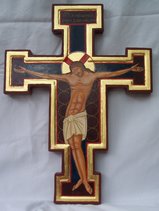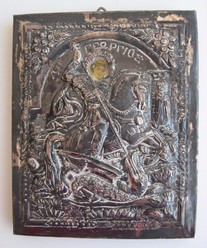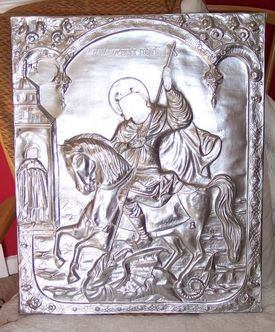 It's not often I find myself in the vanguard of business innovation, so I was really pleased to hear a discussion about the popularity and success of buying art over the web on BBC Radio 4 this morning. I started selling paintings from my website back in 2009 - I think this little crucifix (now somewhere on Orkney) was one of the first commissions I received by internet. I have always been surprised and delighted that people are prepared to buy something so personal as an artwork 'sight unseen'; though the ability to email a high resolution photographic scan is really helpful, and I haven't yet had a buyer ask to return a painting. And my experience is mirrored higher up the feeding chain - apparently on line sales of art have been increasing across the board, even in the four and five figure bracket, and with giants such as Sothebys and Christies. This is a wonderful thing for artists because, provided one can get to grips with the intricacies of on line marketing, it opens the world up for sales and liberates us from selling solely through brick-and-mortar galleries. People are always shocked to hear that an art gallery generally takes 50% of the sale price of a piece, plus VAT on top of that. In London that fee would often be 60% or 70%. Rent and rates on high street premises, glossy brochures and travelling to art fairs and functions all costs a great deal of money even before the gallery's staff costs are paid. It is very hard for a gallery owner to make a living. Unfortunately it is even harder for an artist. To make more than five pence an hour painting an original, an artist's work must command a very good price indeed, involving years spent slowly building a 'name' and nudging up ones prices. A gallery's commission is only the start of the expenses involved in selling. The artist bears the cost of professional framing - if you have ever had a print framed, you will know how expensive that can be. A gallery takes work 'on consignment' - that is to say, the artist is paid nothing for it until it sells, if at all. Often an artist has to pay an up-front annual fee for wall space before the gallery will actively market the work. As a result, many galleries are stocked largely with prints or cheerful-looking canvasses with rorschach blobs and splashes. So dear reader, if you are buying art for your home and want something really original and unique I urge you to become a patron of the arts. Hunt down the artist's website and approach them directly. No prices displayed? It costs nothing to ask!
I am also currently working on the restoration of a big St George icon (dragon and princess this time) a project which I took on in a fit of rash enthusiasm and which I don't mind admitting is giving me a packet of trouble. Fortunately (as I am not a conservator) it is worth nothing either artistically or monetarily: it has sentimental value to the owner, who found it in a junk yard sale, because it reminds him of his Serbian heritage. It is a curious item: it seems to have been cast in resin from the riza on some old icon, complete with nail heads and tack holes. A riza (sometimes oklad, Russian) or revetment is an embossed metal cover made to protect a precious icon from candle smoke and the kisses of the faithful. The embossing echoes the painted design underneath and only the hands and faces of the saint peep out from the cover. I found some examples on line - one a 19th century version in plaster, and another which is copyright. This copy had been sprayed gold and paper prints of faces and hands pasted on the top. A few damp years in a garage, and they had peeled off completely. I am trying to replace them with something a little worthier than paper cut-outs, using gesso on balsa wood and a great deal of ingenuity. St George has also had a respray, silver this time at the client's request, and now he looks like the King of Bling. I can recommend Plasticote Brilliant Metallic spray paints, they really are remarkably convincing.
Courtauld Institute standards it is not, but I hope to turn it into something the client wants to hang in his home. Look back in a while for the faces. And before anyone else asks - no, I do not do restorations. |
The view from my deskCurrent work, places and events, art travel, and interesting snippets about Christian icons, medieval art, manuscript illumination, egg tempera,, gilding, technique and materials. Categories
All
Archives
January 2024
|




 RSS Feed
RSS Feed